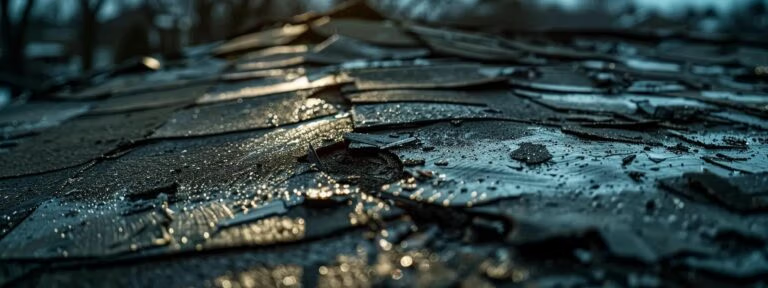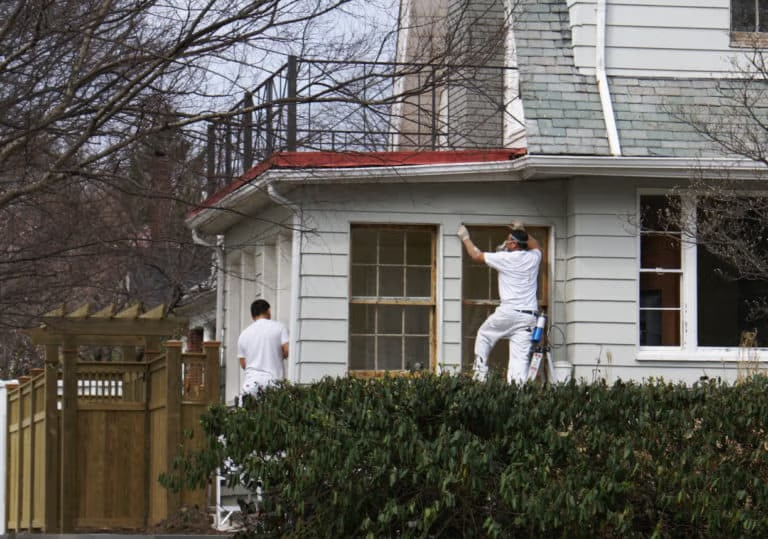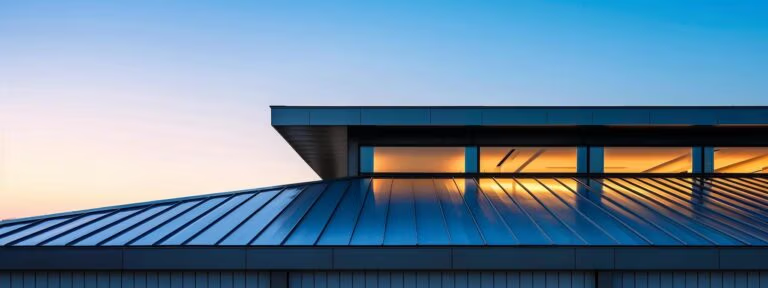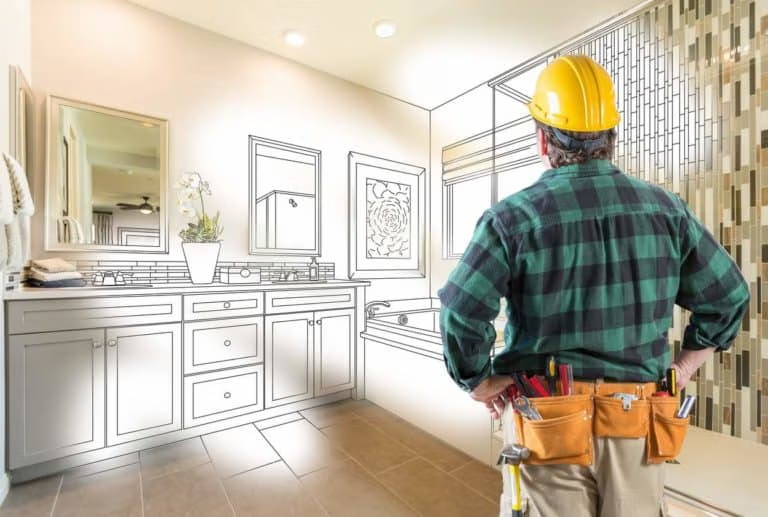Recognizing the signs of a failing roof is essential to ensuring the safety and comfort of your home. Key indicators include curling or buckling shingles, missing tiles, granules collecting in gutters, and water stains on ceilings. A sagging roof deck or visible sunlight streaming into your attic can also signal significant issues. Additionally, increased energy bills often hint at failing insulation, while mold or moss growth points to persistent moisture problems. Damaged flashing and structural dips further highlight underlying vulnerabilities. Staying vigilant can protect your home from costly repairs and severe damage; keep an eye out for these signs to stay ahead.
Key Takeaways
- Curling or buckling shingles indicate roof deterioration.
- Missing shingles can lead to leaks and water damage.
- Water stains on ceilings suggest roof leaks.
- Granules in gutters signal shingle wear and tear.
- Sunlight visible in the attic points to gaps or holes in the roof.
Curling or Buckling Shingles
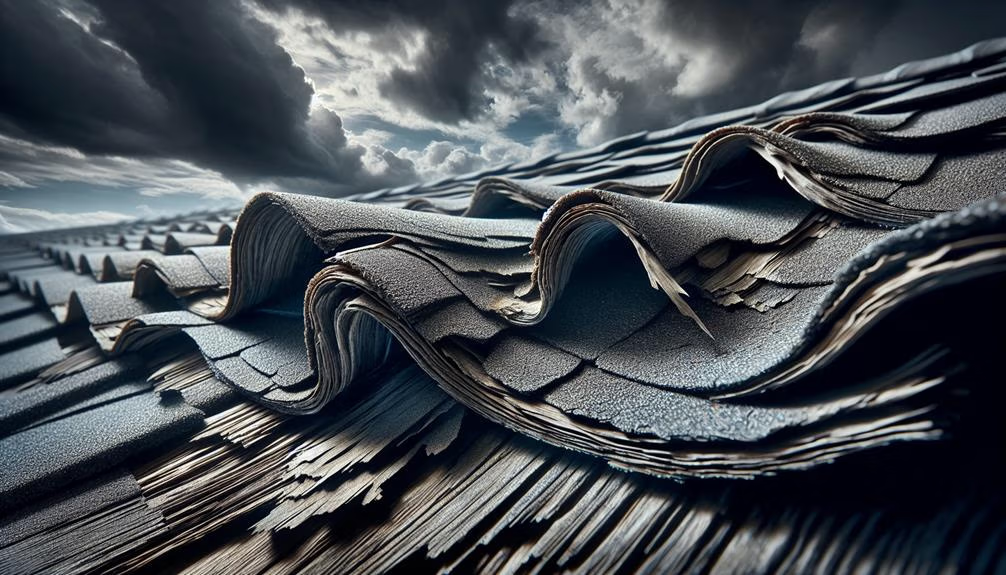
One of the most telling indicators of a deteriorating roof is the presence of curling or buckling shingles, which can compromise the roof's ability to protect your home from the elements. Observing these signs evokes a sense of urgency and concern, as they reveal underlying issues that could lead to extensive damage if left unaddressed. Curling shingles, often caused by prolonged exposure to harsh weather conditions or improper installation, lose their ability to provide an effective barrier against rain, snow, and wind.
From a personal perspective, discovering buckling shingles on my own home felt like uncovering a hidden vulnerability. The once-flat, secure surface had transformed into a landscape of warped and lifted edges, signaling potential trouble. This visual evidence is not just cosmetic; it signifies a weakening structural integrity, inviting moisture to seep through and damage the underlying layers.
In addressing this issue, one must consider immediate repair or, in severe cases, total roof replacement to restore the roof's protective function. Ensuring timely action not only safeguards the home's interior but also preserves its overall value. Thus, curling or buckling shingles serve as a poignant reminder of the importance of regular roof maintenance.
Missing Shingles
The presence of missing shingles is a glaring red flag that demands immediate attention. Often resulting from severe weather conditions or aging materials, these gaps compromise the structural integrity of your roof. Not only do they expose your home to leaks and water damage, but they also signal the urgent need for professional assessment and repair.
Causes of Missing Shingles
Shingles can go missing due to harsh weather conditions, such as high winds or heavy rain, which compromise their attachment and integrity. These natural elements can be relentless, tearing away at the very fabric of our home's protection. But weather isn't the only adversary your roof faces. Other culprits can be equally damaging, leading to the unsettling discovery of missing shingles.
Here are some key causes of missing shingles:
| Cause | Description |
|---|---|
| Age of Shingles | Over time, shingles lose their durability and become brittle, making them more susceptible to breaking or blowing away. |
| Improper Installation | When shingles aren't properly secured during installation, they are more likely to come loose, especially in adverse weather. |
| Falling Debris | Branches or other debris can strike the roof, dislodging or cracking shingles in the process. |
| Poor Maintenance | Neglecting regular roof inspections and maintenance can exacerbate minor issues, leading to shingle loss. |
| Animal Activity | Birds, squirrels, and other animals can disturb or remove shingles as they seek nesting spaces or food. |
Each of these factors chips away at the roof's defenses, leaving it vulnerable to the elements. Recognizing these causes early can help you take steps to mitigate the risks and protect your home. The resilience of your roof depends on vigilance and timely intervention.
Impact on Roof Integrity
When shingles go missing, the very essence of your roof's protective barrier begins to erode, exposing your home to a cascade of potential issues. As a homeowner, this vulnerability can evoke a sense of unease, knowing that what once provided steadfast protection is now compromised. Missing shingles create gaps that permit water infiltration, leading to leaks that can damage your home's interior, from the attic to the very foundation.
Moreover, these gaps can become breeding grounds for mold and mildew, endangering the health of your household. The structural integrity of the roof itself is at risk, as the absence of shingles may allow wood rot to set in, weakening the framework over time. This erosion of stability can escalate repair costs and shorten the overall lifespan of the roof.
From a personal standpoint, the sight of missing shingles can be disheartening, a visual reminder of the deterioration occurring above. It's a call to action, urging you to address the issue promptly. Ignoring the signs can lead to more severe problems and greater financial burden down the line. Therefore, vigilance and timely intervention are crucial in preserving the integrity and longevity of your roof.
Granules in Gutters
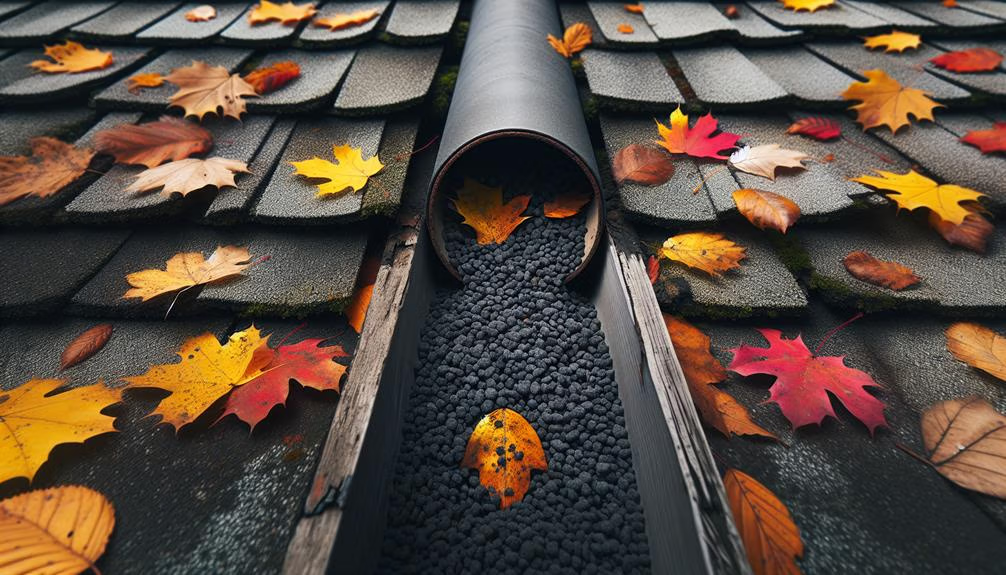
Discovering an accumulation of granules in your gutters can be an alarming indicator of your roof's deteriorating condition. These granules, though often overlooked, play a vital role in safeguarding your shingles from the harsh effects of ultraviolet rays and inclement weather. When they begin to shed into your gutters, it signifies that the protective surface of the shingles is wearing thin, leaving your roof vulnerable to further damage.
From a homeowner's perspective, noticing these granules can evoke a sense of urgency and concern. It is not merely an aesthetic issue; it is a sign that your roof is losing its first line of defense against the elements. This erosion often leads to a cascade of problems, including leaks and structural damage, which can be both emotionally and financially draining.
The gradual loss of granules can be attributed to various factors such as age, severe weather conditions, or even poor-quality roofing materials. It's essential to address this issue promptly. Ignoring it can lead to more severe consequences, potentially compromising the safety and integrity of your entire home. Regular inspections and timely interventions can help mitigate these risks, ensuring your roof remains robust and reliable.
Water Stains on Ceilings
Water stains on your ceilings can be a distressing sign that your roof is struggling to keep your home protected from the elements. These unsightly blemishes often manifest as discolored patches, ranging from yellowish hues to darker brown spots, and can evoke a sense of unease and urgency. They are silent indicators that moisture has breached your roof's defenses, infiltrating the layers of insulation and drywall that keep your home safe and dry.
From a personal perspective, discovering water stains can feel like a betrayal by a roof you've trusted to shield your living space. The emotional toll is compounded by the potential for hidden damage that these stains signify. They are not merely cosmetic flaws; they are harbingers of more extensive issues such as mold growth, structural deterioration, and compromised indoor air quality. Immediate attention is crucial to prevent further damage.
In addressing water stains, it's vital to identify the source of the leak promptly. Professional inspections can pinpoint vulnerabilities, whether it's damaged shingles, deteriorated flashing, or clogged gutters. By taking swift action, you can mitigate the emotional and financial strain of more severe roof failures, ensuring your home remains a sanctuary from the elements.
Sagging Roof Deck

A sagging roof deck is a clear signal that something is amiss with your roofing system. Visible structural dips can indicate underlying issues such as water damage or compromised roofing materials, which can escalate into more severe problems if left unaddressed. Identifying these warning signs early can save homeowners significant stress and expense.
Visible Structural Dips
One of the most alarming indicators of a failing roof is the presence of visible structural dips, often manifesting as a sagging roof deck. This unsettling phenomenon not only disrupts the aesthetic harmony of your home but also signals potential perilous conditions. Imagine the sinking feeling when you notice an uneven skyline, a dip that wasn't there before. It's more than just an eyesore; it is a cry for immediate attention.
From a personal perspective, discovering such a flaw can evoke a sense of urgency and concern. It's a clear indication that the roof's structural integrity has been compromised. This could be due to a variety of factors such as prolonged exposure to heavy loads, deteriorated support beams, or excessive moisture accumulation. Each of these elements contributes to a weakening framework, rendering your home vulnerable to further degradation.
Moreover, the emotional weight of realizing your sanctuary is at risk cannot be understated. You are not just dealing with a structural issue but the potential for significant financial and emotional strain. Taking swift action to address visible structural dips can prevent more severe consequences and restore peace of mind, safeguarding both your home and your well-being.
Water Damage Indicators
Just as visible structural dips signal a compromised roof, the telltale signs of water damage, such as a sagging roof deck, further underscore the urgency of addressing these vulnerabilities. The sight of a sagging deck evokes a sense of worry and helplessness, knowing that underlying issues could be escalating unnoticed. When water infiltrates the roof structure, it gradually weakens the materials, causing them to warp, rot, and lose their integrity.
From my experience, a sagging roof deck is not merely an aesthetic blemish but a red flag demanding immediate attention. This subtle yet significant dip can be an ominous indicator of prolonged water exposure, which if left unchecked, could lead to catastrophic outcomes. The slow degradation brought on by persistent moisture compromises the foundational strength of the roof, ultimately jeopardizing the safety of the entire structure. It's heart-wrenching to realize that what may appear as a minor sag can swiftly evolve into a costly repair or even a complete roof replacement.
In essence, noticing a sagging roof deck should prompt swift action. The sooner the underlying water damage is addressed, the better the chances of salvaging the roof and averting further structural deterioration.
Compromised Roofing Materials
The integrity of roofing materials is paramount, and any signs of sagging in the roof deck highlight a critical failure that demands urgent attention. Sagging often signifies underlying issues such as water damage, structural deficiencies, or deteriorated support beams. This condition not only compromises the roof's aesthetic appeal but also its functional reliability and safety.
From my experience, spotting these signs early can mean the difference between a manageable repair and a complete roof replacement. A sagging roof deck is not just an eyesore; it's a harbinger of potential catastrophe. The emotional and financial burden of ignoring this issue can be overwhelming.
| Cause | Indicator | Risk Level |
|---|---|---|
| Water Damage | Dark Spots, Mold | High |
| Structural Deficiencies | Visible Sagging, Uneven Surfaces | Severe |
| Deteriorated Beams | Cracks, Soft Spots | Critical |
Each of these indicators serves as a red flag, urging homeowners to take immediate action. Neglecting these signs can lead to more severe damage, escalating repair costs, and potential safety hazards. Thus, timely intervention is not just advisable; it's essential. Prioritizing roof health safeguards your home and peace of mind, ensuring a secure and enduring shelter for years to come.
Increased Energy Bills
Rising energy costs often serve as a glaring indicator that your roof might be failing to provide adequate insulation. When a roof loses its integrity, it permits excessive heat transfer between the interior and exterior of the house, leading to soaring heating and cooling expenses. This not only burdens your wallet but also disrupts the comfort and harmony of your living space.
You may notice a significant spike in your utility bills, particularly during extreme weather seasons. This escalation is often accompanied by drafts in your home or uneven temperatures across different rooms. Here are key factors that contribute to increased energy costs due to a failing roof:
- Air Leaks: Gaps and cracks in the roofing material allow conditioned air to escape, making your HVAC system work harder to maintain a stable indoor climate.
- Insulation Deterioration: Over time, the insulation material within your roof can degrade, losing its effectiveness and resulting in higher energy consumption.
- Radiant Heat Transfer: A compromised roof can facilitate the transfer of radiant heat, making your home hotter in summer and colder in winter.
Addressing these issues promptly can help you mitigate rising energy costs and restore comfort to your home, protecting both your finances and well-being.
Mold or Moss Growth
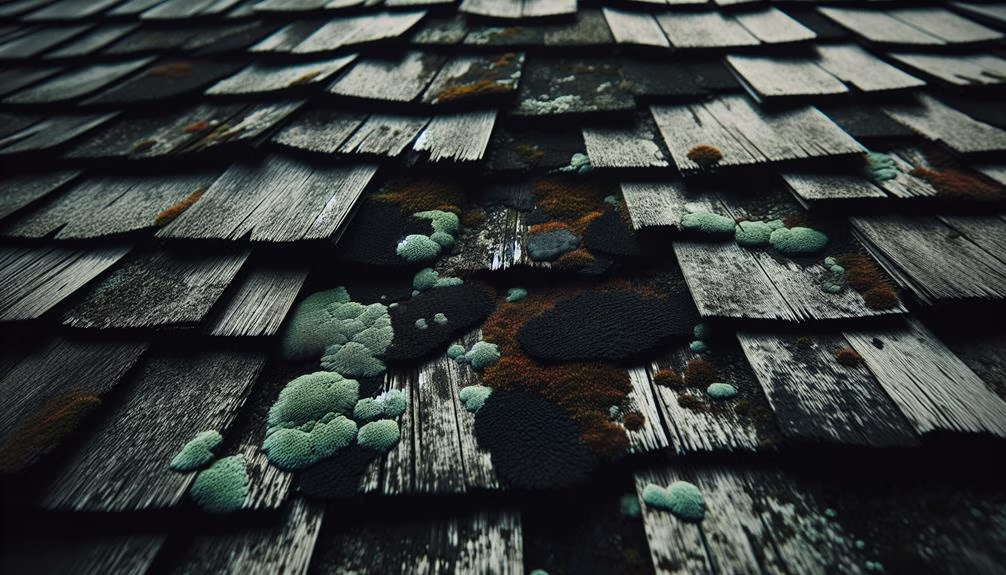
Beyond the financial strain of increased energy bills, another alarming sign of a failing roof is the unwelcome presence of mold or moss growth. These unsightly invaders not only mar the aesthetic appeal of your home but also signal underlying moisture problems that could compromise the structural integrity of your roof. Mold and moss thrive in damp environments, indicating that your roof may be retaining moisture, possibly due to leaks or poor ventilation.
| Sign | Implication |
|---|---|
| Mold Growth | Indicates persistent moisture |
| Moss Growth | Suggests water retention |
| Musty Odors | Points to hidden mold |
| Discolored Spots | Signals water damage |
| Warped Shingles | Evidence of prolonged dampness |
From a personal perspective, discovering mold or moss can be disheartening. It's not just about the visual blemish; it's an ominous sign that your sanctuary may be at risk. Mold spores can infiltrate your living space, affecting indoor air quality and posing health risks. Moss, on the other hand, can lift shingles, making your roof even more susceptible to water infiltration.
In essence, addressing mold or moss growth isn't merely a cosmetic concern but a crucial step in safeguarding your home. Ignoring these signs could lead to extensive repairs and significant financial outlay, making early detection and intervention paramount.
Damaged Flashing
When your roof's flashing becomes damaged, it can lead to severe water intrusion issues that compromise the entire structure of your home. Flashing, typically made from metal or rubber, serves as a barrier preventing water from seeping into vulnerable areas like chimneys, vents, and valleys. Over time, this vital component can corrode, crack, or become dislodged, leading to leaks and extensive water damage. The emotional toll of discovering water stains on your ceiling or peeling paint on your walls is a daunting experience, underscoring the importance of timely detection and repair.
Recognizing the signs of damaged flashing is crucial to maintaining the integrity of your roof. Here are three indicators to watch for:
- Visible Rust or Corrosion: Metal flashing can deteriorate over time, leading to rust patches that compromise its effectiveness.
- Cracks or Tears: Rubber or plastic flashing may develop cracks or tears, especially after severe weather conditions, allowing water to penetrate.
- Loose or Missing Pieces: Flashing that has come loose or gone missing creates gaps for water to infiltrate your home's structure.
Addressing damaged flashing promptly can save homeowners from the heartache and expense of extensive repairs, preserving the sanctity and safety of your home.
Sunlight in Attic
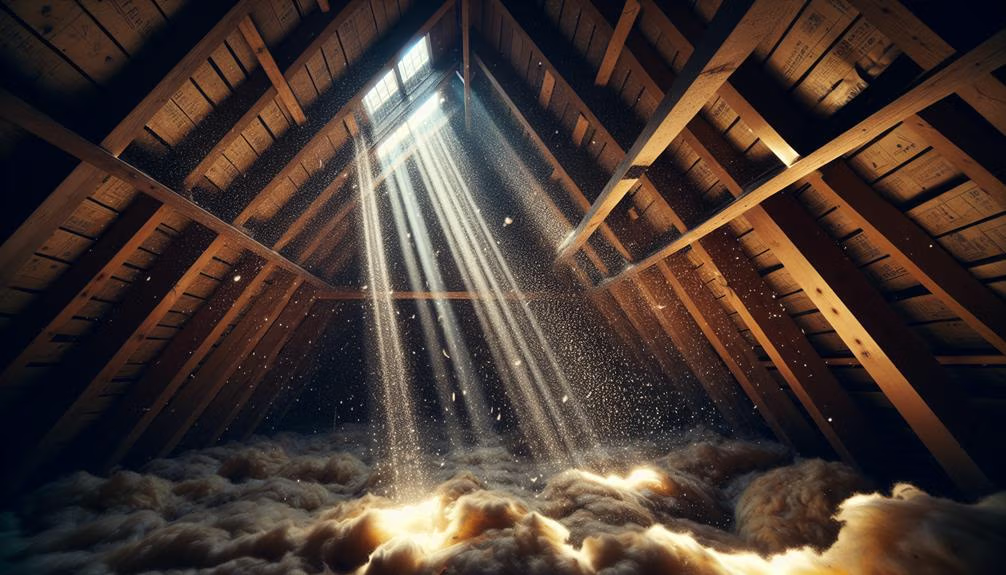
As you inspect your home for signs of roof damage, noticing beams of sunlight streaming through your attic is a glaring indication that your roof may be compromised. This phenomenon is not just about the aesthetic of soft, golden light; it signifies potential structural vulnerabilities that can lead to more serious issues. A moment of realization in your attic, with sunlight piercing through, can evoke a mixed sense of urgency and concern for the well-being of your home.
When sunlight penetrates the attic, it is often due to gaps, cracks, or holes in the roofing material. These openings can allow water to seep in during rainfalls, leading to moisture buildup, mold growth, and eventually, structural decay. Moreover, they can also invite unwelcome pests into your home, compounding the problem.
| Sign | Cause | Potential Consequence |
|---|---|---|
| Sunlight in Attic | Gaps or cracks in roofing | Water leaks, mold, structural decay |
| Visible Holes | Missing shingles or tiles | Increased energy costs, pest entry |
| Light Streams | Deteriorated roofing material | Compromised insulation, damage |
Addressing sunlight in the attic promptly is essential to maintaining the integrity of your roof and, by extension, the safety and comfort of your home.
Frequently Asked Questions
How Often Should I Inspect My Roof for Damage?
Regular roof inspections are crucial to maintaining your home's integrity. Ideally, you should inspect your roof at least twice a year, in the spring and fall, to catch any seasonal damage. Additionally, after severe weather events such as storms or heavy snowfall, a prompt inspection can prevent minor issues from escalating. This proactive approach ensures longevity and peace of mind, safeguarding your investment and providing a secure living environment.
Can a Roof Leak Cause Structural Damage to My Home?
Absolutely, a roof leak can cause significant structural damage to your home. When water seeps in, it doesn't just stay put; it can lead to wood rot, mold growth, and even compromise the integrity of your ceilings and walls. In my experience, a stitch in time saves nine—addressing roof leaks promptly can prevent a cascade of costly repairs and ensure the safety and longevity of your home.
What Should I Do if I Find Small Cracks in My Roof?
Discovering small cracks in your roof can be concerning. From my experience, it's crucial to address these issues promptly. Start by inspecting the affected area thoroughly to assess the extent of the damage. Then, consult a professional roofer to evaluate the necessity of repairs or replacements. Ignoring these minor cracks could lead to more significant problems, including leaks and structural damage, jeopardizing the safety and integrity of your home.
How Long Does a Typical Roof Last Before Needing Replacement?
Ah, the age-old question that haunts homeowners: "How long does a typical roof last before it needs replacement?" Like a well-worn pair of shoes, a roof's lifespan varies. Generally, asphalt shingles last 20-30 years, while metal roofs can endure 40-70 years. Factors such as climate, maintenance, and material quality play pivotal roles. So, cherish your roof while it lasts, for it shelters you from the storms of life.
Are There Any Specific Roof Maintenance Tasks to Perform Seasonally?
When considering seasonal roof maintenance, one should clean gutters in the fall to prevent blockages, inspect for and repair any damage caused by winter's harsh conditions in the spring, and ensure proper ventilation during summer to avoid overheating. Regular inspections and minor repairs can significantly extend a roof's lifespan, making it a crucial practice in preserving the structural integrity and functionality of your home.
Conclusion
As the roof stands as a sentinel against the elements, its deterioration whispers through curling shingles, missing patches, and granules littering the gutters. The ominous shadows of water stains and the unsettling sag of the roof deck foreshadow greater calamities. Elevated energy bills, the encroachment of mold, and damaged flashing all sound the alarm, while errant sunlight piercing the attic underscores the urgency for intervention. The roof's silent cries demand swift action to prevent further descent into disrepair.


